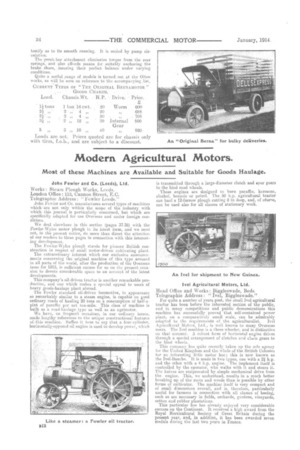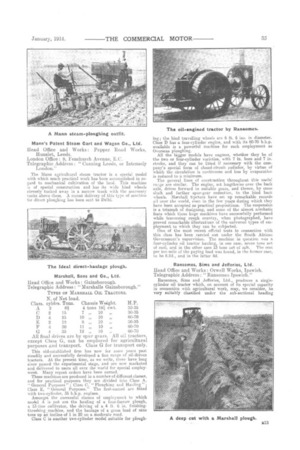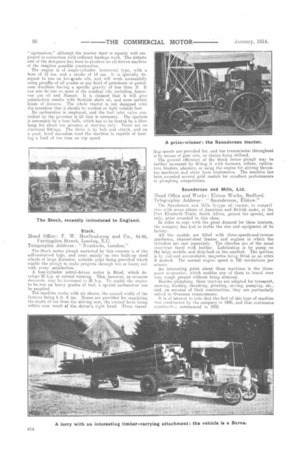Modern Agricultural Motors.
Page 34

Page 35

Page 36

If you've noticed an error in this article please click here to report it so we can fix it.
Most of these Machines are Available and Suitable for Goods Haulage.
John Fowler and Co. (Leeds), Ltd.
Works : Steam Plough Works, Leeds. London Office : 113, Cannon Street, E.C. Telegraphic Address : " Fowler Leeds."
John Fowler and Co. manufactures several types of machines which arenot, only within the scope of the industry with which this journal is particularly concerned, but which are specifically adapted for use Overseas and under foreign conditions.
We deal elsewhere in this sectioa (pages 37-38) with the Fowler-Wyles motor plough in its latest form, and we need not, in the present notice, do more than direct the attention of our readers to those pages in connection with this interesting development.
The Fowler,Wyles plough stands for pioneer British Construction in respect of small motor-driven cultivating plant. The extraordinary interest which our exclusive announcements concerning the original machine of this typo aroused in all parts of the world, after the production of the Overseas issue for 1913, is sufficient excuse for us on the present occasion to devote considerable space to an acceutit of the latest developments.
This company's oil-driven tractor is another remarkable production, and one which makes a special appeal to users of heavy goods-haulage plant abroad. The Fowler standard oil-driven locomotive, in appearance so remarkably similar to a steam engine, is capable on good ordinary roads of hauling 20 tons on a consumption of half-apint of paraffin per net ton-mile. This class of machine is built as a road-haulage type as well as an agrimotor.
We have, on frequent occasions, in our. ordinary issues, made lengthy references to the unique constructional features of ,this machine. Suffice it here to say that a .four-cylinder, horizontally-opposed oil engine is used to develop power, which
is transmitted through a large-diameter clutch and spur gears to the hind road wheels.
These engines are designed to burn paraffin, kerosene, alcohol, benzole or petrol. The 50 h.p_ agricultural tractor can haul a 12-furrow plough cutting 8 in deep, and, of course, can be used also for all classes of stationary work.
An Ivel for shipment to New Guinea. Ivel Agricultural Motors, Ltd.
Head Office and Works: Biggleswade, Beds.
Telegraphic Address : "Ivel, Biggleswade."
For quite a number of years past, the small. Ivel agricultural tractor has been before the interested section of the public, and in many competitions and public demonstrations this machine has successfully proved that self-contained power plant, on a comparatively small scale, can be admirably adapted to the requirements of the agriculturalist. Ivel Agricultural Moters, Ltd., is well known to many Overseas users. The Ivel machine is a three-wheeler, and is distinctive on that account. A robust form of horizontal engine drives through a special arrangement of clutches and chain gears to the hind wheels.
This company has quite recently taken up the sole agency for the 'United Kingdom and the whole of the British Colonies for an interesting little motor hoe; this is now known as the Ivel-13auche. It is made in two types, one with a 2i h.p. and the other with a 4 h.p. engine. The implement itself is controlled by the operator, who walks with it and steers it. The knives arc reciprocated by simple mechanical drive from the engine. This, we understand, results in a much better breaking up of the roots and weeds than is possible by other ferias of cultivator. The machine itself is very compact and of small dimensions overall, and is, therefore, particularly useful for farmers in connection with all classes of hoeing, such as are necessary in fields, orchards, gardens, vineyards, cotton and rubber plantations.
This particular hoe has already enjoyed very considerable success on the Continent. It received a high award from the Royal Horticaltaral Society of Great Britain during the present year, and, in addition, it has been awarded seven medals daring the last two years in rrance.
A Mann steam-ploughing outfit. Mann's Patent Steam Cart and Wagon Co., Ltd.
Head Office and Works : Pepper Road Works, Hunslet, Leeds.
London Office : 9, Fenchurch Avenue, E.C.
Telegraphic Address : " Canning Leeds, or Intensely London."
The Mann agricultural steam tractor is a special model with which much practical work has been accomplished in regard to mechanical cultivation of the land. This machine is of special construction and has its wide hind wheels cleverly tucked away in a narrow track with the necessary tanks above them. A recent delivery of this type of machine for direct ploughing has been sent to Delhi.
The Ideal direct-haulage plough. Marshall, Sons and Co., Ltd.
Head Office and Works : Gainsborough. Telegraphic Address : " Marshalls Gainsborough."
TYPES OF MARSHALL OIL TRACTORS.
All final drives are by spur guars. All oil tractors, except Class G, can be employed for agricultural purposes and transport. Class G for transport only.
This old-established firm has now for SOM e years past steadily and successfully developed a fine range of oil-driven tractors. At the present time, as we write, these have long since passed the experimental stage, and are now marketed and, delivered to users all over the world for special employment. Many repeat orders have been earned. These machines are produced in a number of different classes, and for practical purposes they are divided into Class A, " General Purposes" ; Class CI, "Ploughing and Hauling" ; Class E, "General Purposes." The Fast-named are fitted with two-cylinder, 35 b.h.p. engines. Amongst the successful classes of employment to which model A is put are the hauling of a four-furrow plough, a 13-tine cultivator, the driving of a 4 ft. 6 in. finishingthreshing .machine, and the haulage of a gross load of nine tons up an incline of 1 in 20 on a moderate road.
Class C is another two-cylinder model suitable for plough.
ing; the hind travelling wheels are 6 ft. 6 ins, in diameter. Class D has a four-cylinder engine, and with its 60-70 b.h.p. available is a powerful machine for such employment as Overseas ploughing.
All the bigger models have engines, whether they be of the two or four-cylinder varieties, with 7 in. bore and 7 in. stroke, and they can be fitted if necessary with the company's special form of closed-circuit radiator, by virtue of wbich the circulation is continuous and loss by evaporation is reduced to a minimum.
The general lines of construction throughout this useful range are similar. The engine, set lengthwise over the back axle, drives forward to suitable gears, and thence, by cross shaft and further spur-gear reduction, to the hind back wheels. Mawsliall tractors have set up remarkable records all over the world, even in the few years during which they have been accepted as practical propositions. The suspension is a triumph of designing, and some of the almost acrobatic feats which these huge machines have successfully performed while traversing rough country, when photographed, have proved remarkable illustrations of the universal types of employment to which they can he subjected. One of the most recent official tests in connection with this, class has been carried out under the South African Government's supervision. The machine in question was a four-cylinder oil tractor hauling, in one case, seven tons net of coal, and in the other case 13 toms net of salt. The cost per ton-mile of the paying load was found, in the former case, to be 6.8d., and in the latter 4d.
Ransomes, Sims and Jefferies, Ltd.
Head Office and Works : Orwell Works, Ipswich. Telegraphic Address : " Ransomes Ipswich."
Ransomes, Sims and Jefferies, Ltd., produen3 a singlecylinder oil tractor which, on account of its special capacity in connection with agricultural work, may, we consider, be very suitably classified under the sub-sectional heading " agrimotors," although the tractor itself is equally well employed in connection with ordinary haulage work. The definite aim of the designers has been to produce an oil-driven machine of the simplest possible construction.
The engine is of single-cylinder, horizontal type, with a bore of 12 ins, and a stroke of 14 ins. It is specially designed to run on low-trade oils, and will work successfully rising paraffin of all grades or any kind of petroleum or
corn distillatedistillate having a specific gravity of less than P. It can also he run on most of the residual oils, including American gas oil and Mazout. It is claimed that it will give satisfactory results with Scottish shale oil, and even certain kinds of creosote. The whole tractor is not designed with the intention that it should he worked on light volatile fuel. No carburetter is employed, and the foel inlet valve controlled by the governor is all that is necessary. The ignition is automatic by a heat hull), which has to be heated by a blow lamp for about ten minutes at starting only. There are no electrical fittings. The drive is by belt and clutch, and on a gond, level macadam road the manhine is capable of hauling a load of ten tons on top speed.
Stock.
Head Office: F. W. Moellenkamp and Co., 84-85, Farringdon Street, Londou, E.C.
Telegraphic. Address : " Noxitudo, London."
The Stook motor plough marketed by this Concern is of the self-contained type, and rests mainly on two built-up steel wheels of large diameter, suitable grips being provided which enable the plough to make progress through wet or loamy soil with every satisfaction,
A four-cylinder petrol-driven motor is fitted, which develops 42 h.p. at normal running. This, however, as occasion demands, may be increased to 50 h.p. To enable the engine to be run on heavy grades of fuel, a special carburetter can be supplied.
The machine works with six shares, the overall width of the furrows being 6 ft. 6 ins. Means are provided for regulating the depth of cut from the driving seat, the control lever being within easy reach ef the drivar s right hand. Three travel ling speeds are provided for, and trio transmission throughout is by means of gear sets, no chains being utilized. The general efficiency of the Stock motor plough may be further increased by fitting it with harrows, rollers, cultivators, binders, planters, or using the engine for driving threshing machines and other farm implements. The machine has been awarded several gold medals for excellent performances in ploughing competitions.
Saunderson and Mills, Ltd.
Head Office and Works.: Elstow Works, Bedford. Telegi aphic Address : " Saunderson, Ellstow."
The Saunderson and Mills G-type oil tractor, in competi Lion with seven others of American and British make, at the Port Elizabeth Trials, South Africa, gained the special, and only, prize awarded in this class.
In order to cope with the great demand for these tractors, the company has had to treble the size and equipment of its factory,
All the models are fitted with three-speeds-and-reverse gearboxes, channel-steel frames, and engines in which the cylinders are cast separately. The clutches are of the usual cone-type faced with leather. Lubrication is by pump on the large models, and drip-feed on the smallest. The ignition is b.y coil and accumulator, magnetos being fitted as an extra if desired. The normal engine speed is 750 revolutions per minute.
An interesting point about these machines is the threepaint suspension, which enables any of them to travel over very rough ground without being strained. Besides ploughing, these tractors are adapted for transport, mowing, binding, threshing, grinding, sawing, pumping, otc., and, on account of their construction, they are partiyularly suited to Overseas requirements.
It is of interest to note that the first of Ibis type of machine was constructed by tha company in 18%, and that continuous constriintinn commenced in 1903.






















































































